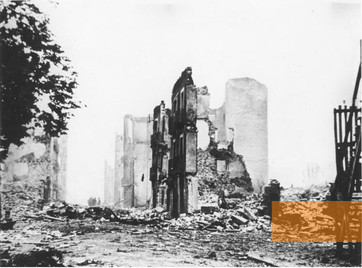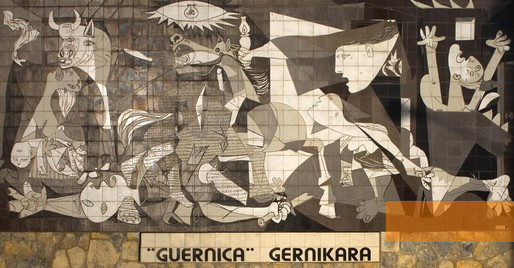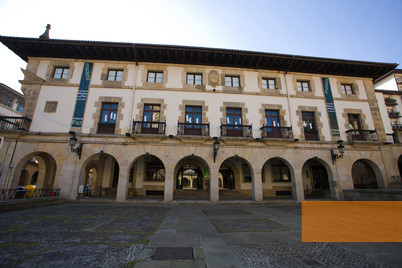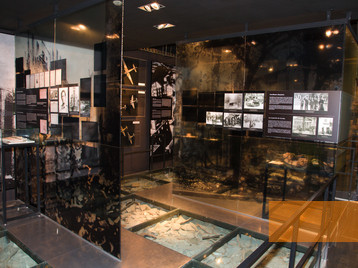On April 26, 1937 the old city of Gernika in northern Spain, known as the »Holy City of the Basques«, was bombed and totally destroyed by the German »Legion Condor« and the Italian air force. Hundreds of civilians died. Pablo Picasso recorded the event in 1937 in his monumental painting. In 1998, a museum was opened to inform about the bombing and the Spanish Civil War.
Gernika (Spanish: Guernica) is a small town in Basque country, located in the North-East of Bilbao. For many Basques, the town has been a symbol of their fight for freedom and independence for centuries.
The Basque Country was one of the theatres of the Spanish Civil War of 1936 until 1939. On April 26, 1937, German and Italian war planes attacked the city. They were supposed to facilitate the entry of General Franco's nationalist soldiers into the town. In Gernika, there were no military units of the Republican side to speak of, however, the town was full of war refugees and of peasants visiting the market on that day. The tactical objective of the attack was to destroy a bridge over the river Oca. The German »Legion Condor« and the Italian squadrons flew numerous waves of attack on the city. The planes, with over 20 modern German Ju 52 among them, also used firebombs which would have been completely useless against the stone bridge. The old town was destroyed completely, several hundred civilians perished. The bridge was not damaged in the attack.
The Basque Country was one of the theatres of the Spanish Civil War of 1936 until 1939. On April 26, 1937, German and Italian war planes attacked the city. They were supposed to facilitate the entry of General Franco's nationalist soldiers into the town. In Gernika, there were no military units of the Republican side to speak of, however, the town was full of war refugees and of peasants visiting the market on that day. The tactical objective of the attack was to destroy a bridge over the river Oca. The German »Legion Condor« and the Italian squadrons flew numerous waves of attack on the city. The planes, with over 20 modern German Ju 52 among them, also used firebombs which would have been completely useless against the stone bridge. The old town was destroyed completely, several hundred civilians perished. The bridge was not damaged in the attack.
The Basque government at the time reported 1,654 victims. Historians claim today that this number might have been exaggerated and a lower number of around 300 is more realistic. 80 percent of the town was destroyed. Especially the effects of the ensuing fire were devastating.
News of Gernika's destruction spread around the world. For many, it became the symbol for the just cause of the Republican side, while for others it stood for for the horrors of war altogether. It was the first time in the history of warfare that a city was completely destroyed by aerial bombing.
The destruction of Gernika inspired Pablo Picasso (1881–1973) for one of his most famous works, the monumental painting »Guernica«. It was already exhibited in the same year at the World Exhibition in Paris. After the death of Franco, the painting came to Spain in 1981 and has been on display in Madrid since then. Many Basques demand that the painting be brought to Basque country. In Gernika, there is a full-size copy of the painting as a mural made of tiles.
In 1998, 61 years after the bombing, the city administration opened a museum about the bombing and the Spanish Civil War. In 2002 the museum broadened its mandate, leading to the creation of the Foundation Peace Museum Gernika. The foundation works closely with other institutions including peace research centres, and has a wide range of educational activities dealing not only with history but also with the challenges for peace today.
The destruction of Gernika inspired Pablo Picasso (1881–1973) for one of his most famous works, the monumental painting »Guernica«. It was already exhibited in the same year at the World Exhibition in Paris. After the death of Franco, the painting came to Spain in 1981 and has been on display in Madrid since then. Many Basques demand that the painting be brought to Basque country. In Gernika, there is a full-size copy of the painting as a mural made of tiles.
In 1998, 61 years after the bombing, the city administration opened a museum about the bombing and the Spanish Civil War. In 2002 the museum broadened its mandate, leading to the creation of the Foundation Peace Museum Gernika. The foundation works closely with other institutions including peace research centres, and has a wide range of educational activities dealing not only with history but also with the challenges for peace today.
- Name
- Fundación Museo de la Paz de Gernika
- Address
-
Plaza de los Fueros, 1
48300 Gernika - Phone
- +34 (0)94 627 021 3
- Fax
- +34 (0)94 625 860 8
- Web
- www.peacemuseumguernica.org
- museoa@gernika-lumo.net
- Open
- Tuesday - Saturday: 10 a.m. – 7 p.m.
Sunday: 10 a.m. – 2 p.m. - Possibilities
- Tours in various languages, educational programmes for children, adults and groups about the culture of peace, the bombing of Gernika and Spanish Civil War, documentation Centre, library, organisation of international conferences







